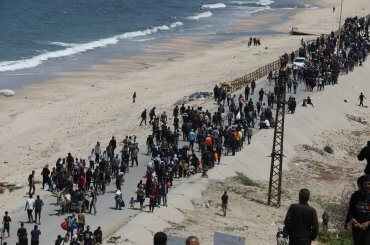“Targets struck” has no meaning without a definition, and it means nothing in comparison with “rockets fired.” Struck by how many of what needs to be defined. Israel was firing rockets and shells, and dropping bombs all of various sizes – some gigantic – from planes, boats, drones, artillery and tanks, all at “targets.” A somewhat more valid comparison might have noted the number of Israeli rockets, shells and bombs, versus the number of Palestinian rockets and mortars. An even more accurate analysis would have compared the tons of ordnance or explosives used by both sides. Comparing “targets struck” to “rockets fired” doesn’t even reach the level of comparing apples and oranges.

These statistics, seemingly provided regularly by the apparently unbiased Israeli army, appeared to be at best a lazy, and at worse a deliberately deceptive way, for the New York Times to shield readers from what was clearly a dramatically imbalanced situation, by repeating an Israeli government framing of events.
I had just this morning sent off perhaps my fifth email to New York Times reporters and editors asking if they should not address their inappropriate use of this comparison over a one month period, when I was shocked to find that they had returned to the comparison again today! In an article posted online this afternoon summarizing the aftermath of the fighting, Jodi Rudoren wrote again, suggesting near parity, “But many analysts and others criticized Mr. Netanyahu’s leadership of the campaign, in which the Israeli military said it struck 5,263 targets in Gaza, while 4,564 rockets and mortars were fired at Israel.”
The continued use of this comparison, despite concerns raised about them, is to me inexplicable and suggests a complete lack of accountability to the truth. On July 16th, Sarah Leah Whitson of Human Rights Watch raised concerns about the comparison with relevant New York Times staff, but The Times continued using it daily, with no changes. Sunjeev Bery of Amnesty USA tweeted concerns about these New York Times statistics on July 30th. On August 2nd on Mondoweiss, I noted a very rough comparison, suggesting that, as of July 16th, Israel may have fired 5.49 times as much ordnance at Gaza as Palestinians fired at Israel, and this was likely an underestimate of the disparity. Sunjeev Bery repeated his concerns about this Times interactive in more detail on the Huffington Post on August 8th , and his article was later posted again by Amnesty USA.
In the meantime, statistics reported over the last few weeks have proven beyond any doubt the absurdity of this comparison, but Times reporters seem not to be paying attention to them. What in the world do “5,263 targets in Gaza” have to do with 59,973 Israeli strikes, 7000 shells fired into Shija’iya in 24 hours, 1000 shells fired at Rafah in 3 hours, and 32,000 total artillery shells fired?
—–
The Israeli military said Wednesday it had struck 5,263 targets in Gaza, many with multiple bombs, missiles and shells. Palestinians estimate 10,800 buildings were demolished and more than 50,000 others damaged, including 277 schools, 270 mosques and 10 hospitals.Hamas and other militant groups fired 4,564 rockets and mortars, the Israeli military said, 3,641 of which exploded in its territory, while 735 were intercepted by the Iron Dome missile defense system.
Today on Al Jazeera, Mark Perry reported on the 7000 shells fired in 24 hours, writing, “According to this senior U.S. officer, who had access to the July 21 Pentagon summary of the previous 24 hours of Israeli operations, the internal report showed that 11 Israeli artillery battalions — a minimum of 258 artillery pieces, according to the officer’s estimate — pumped at least 7,000 high explosive shells into the Gaza neighborhood, which included a barrage of some 4,800 shells during a seven-hour period at the height of the operation. Senior U.S. officers were stunned by the report.”
Euromid reported on August 24 that, “Gaza has been hit 59,973 times — 7,690 by air, 15,673 from the sea and 36,610 on the ground.” Euromid’s figures seem to reflect about the same level magnitude as statistics reported in the Israeli press. Ha’aretz reported on August 15th that, “On July 20, some 600 artillery shells were fired in less than an hour at the east Gaza City neighborhood of Shujaiyeh, in order to extract troops under fire….” “On August 1, in Rafah, more than 1,000 artillery shells were fired in the three hours following a Hamas cell’s capture of Lt. Hadar Goldin….” And “It is thought that at least 32,000 artillery shells were fired in Protective Edge.”
On August 14th, YNET reported, “The IDF provided its combat brigades with 4.8 million bullets, 43,000 artillery shells and 39,000 tank shells. Sources in Atal estimate that 60 percent of the supply was used, while the rest was returned to storage.”
The New York Times repeated and continued use of this comparison between “rockets fired” and “targets struck” constitutes journalistic malpractice. The only question is whether anyone within The New York Times will address this issue. Based on the record, I’m not hopeful.
And all this leaves aside another important and related failure –The New York Times failure to ever detail Israel’s vast military arsenal, and the origin of much of it in the US, despite The Times repeated articles on Palestinian rockets and tunnels. At least The Washington Post did finally take one step in reporting on that issue.



Another great dissection of the NYT’s thoroughly & deliberately biased Israel- centric “reporting”.
I am glad you read it so I don’t have to, Patrick. I’ve even taken to only scanning the Wapo. Too much hasbara in the articles and in the comments.
On a bright (?) note, we are not alone. Read this by Yarden Katz:
https://mondoweiss.mystagingwebsite.com/2014/08/israels-information-dome.html
Thank you for this, Patrick. It is enraging, but important to know.
Mouin Rabbani wrote on his Facebook page on Tuesday, “When an army reaches the point of destroying apartment buildings as if it were a municipal engineer, it can no longer be considered a serious army.”
Will the NYT ever get around to talking about Lehava and the fragility of Israeli democracy ?
http://forward.com/articles/204722/atop-a-wedding-cake-a-threat-to-israeli-democracy
Some years ago, the Chicago Reader newspaper had a column dedicated the critique of a particularly irritating columnist in the Chicago Tribune, Bob Greene. The Reader column was subtitled: “We read him so you don’t have to”.
I feel you are providing the same service for all MW readers with the NYT. Every time you do, you confirm my decision to cancel my ten year subscription to the NYT last year. Thank you.